Comparative Analysis of SDLC Models: HND Semester 2 Report on Systems
VerifiedAdded on 2021/08/23
|47
|18551
|217
Report
AI Summary
This report, submitted by a student as part of their HND second-semester coursework, provides a comprehensive evaluation of different System Development Life Cycle (SDLC) models. It begins with an introduction to the importance of technology and the SDLC, highlighting its role in managing software development projects. The report then delves into detailed discussions of various SDLC models, including the Waterfall model, Spiral model, Prototype model, RAD (Rapid Application Development), Agile model, and DSDM (Dynamic System Development Method). Each model is examined in terms of its advantages, disadvantages, and suitability for different project scenarios. The report also covers topics such as system investigation, feasibility studies (technical, economic, legal, operational, schedule, and social), fact-finding techniques (questionnaires, document investigation, observations, focus groups, research, and site visits), and the analysis of existing and new systems. The report incorporates diagrams such as context diagrams, use case diagrams, DFDs, and ER diagrams to illustrate the concepts discussed. Overall, the report offers a structured and in-depth analysis of SDLC models, providing valuable insights for students and professionals in the field of system development.

Submitted by Dipak Chhetri (HND / Second Semester)
SUBMITTED TO: Kamal Dhakal
SAD
SUBMITTED TO: Kamal Dhakal
SAD
Paraphrase This Document
Need a fresh take? Get an instant paraphrase of this document with our AI Paraphraser
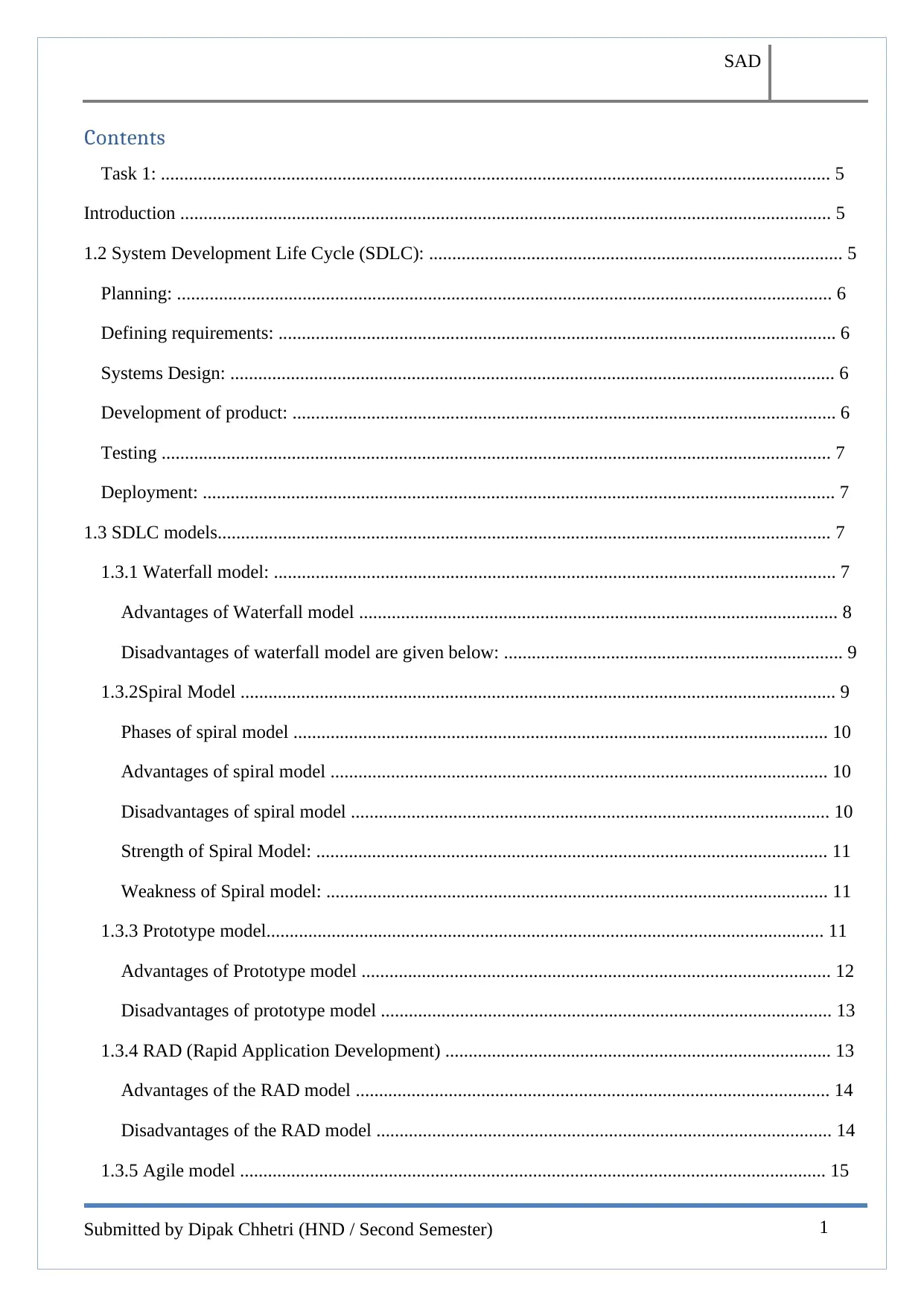
SAD
Submitted by Dipak Chhetri (HND / Second Semester) 1
Contents
Task 1: ................................................................................................................................................ 5
Introduction ............................................................................................................................................ 5
1.2 System Development Life Cycle (SDLC): ......................................................................................... 5
Planning: ............................................................................................................................................. 6
Defining requirements: ........................................................................................................................ 6
Systems Design: .................................................................................................................................. 6
Development of product: ..................................................................................................................... 6
Testing ................................................................................................................................................ 7
Deployment: ........................................................................................................................................ 7
1.3 SDLC models.................................................................................................................................... 7
1.3.1 Waterfall model: ......................................................................................................................... 7
Advantages of Waterfall model ....................................................................................................... 8
Disadvantages of waterfall model are given below: ......................................................................... 9
1.3.2Spiral Model ................................................................................................................................ 9
Phases of spiral model ................................................................................................................... 10
Advantages of spiral model ........................................................................................................... 10
Disadvantages of spiral model ....................................................................................................... 10
Strength of Spiral Model: .............................................................................................................. 11
Weakness of Spiral model: ............................................................................................................ 11
1.3.3 Prototype model........................................................................................................................ 11
Advantages of Prototype model ..................................................................................................... 12
Disadvantages of prototype model ................................................................................................. 13
1.3.4 RAD (Rapid Application Development) ................................................................................... 13
Advantages of the RAD model ...................................................................................................... 14
Disadvantages of the RAD model .................................................................................................. 14
1.3.5 Agile model .............................................................................................................................. 15
Submitted by Dipak Chhetri (HND / Second Semester) 1
Contents
Task 1: ................................................................................................................................................ 5
Introduction ............................................................................................................................................ 5
1.2 System Development Life Cycle (SDLC): ......................................................................................... 5
Planning: ............................................................................................................................................. 6
Defining requirements: ........................................................................................................................ 6
Systems Design: .................................................................................................................................. 6
Development of product: ..................................................................................................................... 6
Testing ................................................................................................................................................ 7
Deployment: ........................................................................................................................................ 7
1.3 SDLC models.................................................................................................................................... 7
1.3.1 Waterfall model: ......................................................................................................................... 7
Advantages of Waterfall model ....................................................................................................... 8
Disadvantages of waterfall model are given below: ......................................................................... 9
1.3.2Spiral Model ................................................................................................................................ 9
Phases of spiral model ................................................................................................................... 10
Advantages of spiral model ........................................................................................................... 10
Disadvantages of spiral model ....................................................................................................... 10
Strength of Spiral Model: .............................................................................................................. 11
Weakness of Spiral model: ............................................................................................................ 11
1.3.3 Prototype model........................................................................................................................ 11
Advantages of Prototype model ..................................................................................................... 12
Disadvantages of prototype model ................................................................................................. 13
1.3.4 RAD (Rapid Application Development) ................................................................................... 13
Advantages of the RAD model ...................................................................................................... 14
Disadvantages of the RAD model .................................................................................................. 14
1.3.5 Agile model .............................................................................................................................. 15
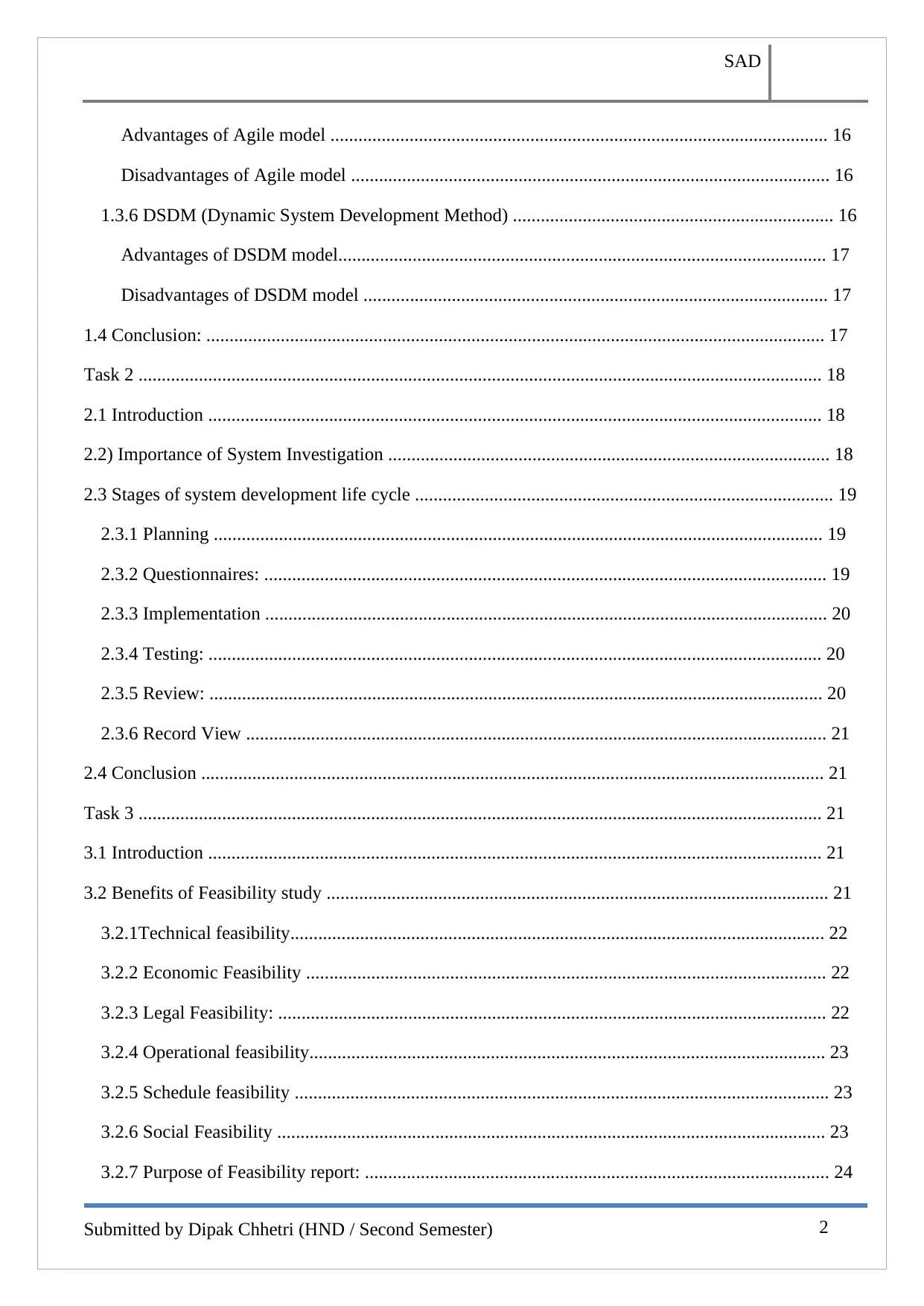
SAD
Submitted by Dipak Chhetri (HND / Second Semester) 2
Advantages of Agile model ........................................................................................................... 16
Disadvantages of Agile model ....................................................................................................... 16
1.3.6 DSDM (Dynamic System Development Method) ..................................................................... 16
Advantages of DSDM model......................................................................................................... 17
Disadvantages of DSDM model .................................................................................................... 17
1.4 Conclusion: ..................................................................................................................................... 17
Task 2 ................................................................................................................................................... 18
2.1 Introduction .................................................................................................................................... 18
2.2) Importance of System Investigation ............................................................................................... 18
2.3 Stages of system development life cycle .......................................................................................... 19
2.3.1 Planning ................................................................................................................................... 19
2.3.2 Questionnaires: ......................................................................................................................... 19
2.3.3 Implementation ......................................................................................................................... 20
2.3.4 Testing: .................................................................................................................................... 20
2.3.5 Review: .................................................................................................................................... 20
2.3.6 Record View ............................................................................................................................. 21
2.4 Conclusion ...................................................................................................................................... 21
Task 3 ................................................................................................................................................... 21
3.1 Introduction .................................................................................................................................... 21
3.2 Benefits of Feasibility study ............................................................................................................ 21
3.2.1Technical feasibility................................................................................................................... 22
3.2.2 Economic Feasibility ................................................................................................................ 22
3.2.3 Legal Feasibility: ...................................................................................................................... 22
3.2.4 Operational feasibility............................................................................................................... 23
3.2.5 Schedule feasibility ................................................................................................................... 23
3.2.6 Social Feasibility ...................................................................................................................... 23
3.2.7 Purpose of Feasibility report: .................................................................................................... 24
Submitted by Dipak Chhetri (HND / Second Semester) 2
Advantages of Agile model ........................................................................................................... 16
Disadvantages of Agile model ....................................................................................................... 16
1.3.6 DSDM (Dynamic System Development Method) ..................................................................... 16
Advantages of DSDM model......................................................................................................... 17
Disadvantages of DSDM model .................................................................................................... 17
1.4 Conclusion: ..................................................................................................................................... 17
Task 2 ................................................................................................................................................... 18
2.1 Introduction .................................................................................................................................... 18
2.2) Importance of System Investigation ............................................................................................... 18
2.3 Stages of system development life cycle .......................................................................................... 19
2.3.1 Planning ................................................................................................................................... 19
2.3.2 Questionnaires: ......................................................................................................................... 19
2.3.3 Implementation ......................................................................................................................... 20
2.3.4 Testing: .................................................................................................................................... 20
2.3.5 Review: .................................................................................................................................... 20
2.3.6 Record View ............................................................................................................................. 21
2.4 Conclusion ...................................................................................................................................... 21
Task 3 ................................................................................................................................................... 21
3.1 Introduction .................................................................................................................................... 21
3.2 Benefits of Feasibility study ............................................................................................................ 21
3.2.1Technical feasibility................................................................................................................... 22
3.2.2 Economic Feasibility ................................................................................................................ 22
3.2.3 Legal Feasibility: ...................................................................................................................... 22
3.2.4 Operational feasibility............................................................................................................... 23
3.2.5 Schedule feasibility ................................................................................................................... 23
3.2.6 Social Feasibility ...................................................................................................................... 23
3.2.7 Purpose of Feasibility report: .................................................................................................... 24
⊘ This is a preview!⊘
Do you want full access?
Subscribe today to unlock all pages.

Trusted by 1+ million students worldwide
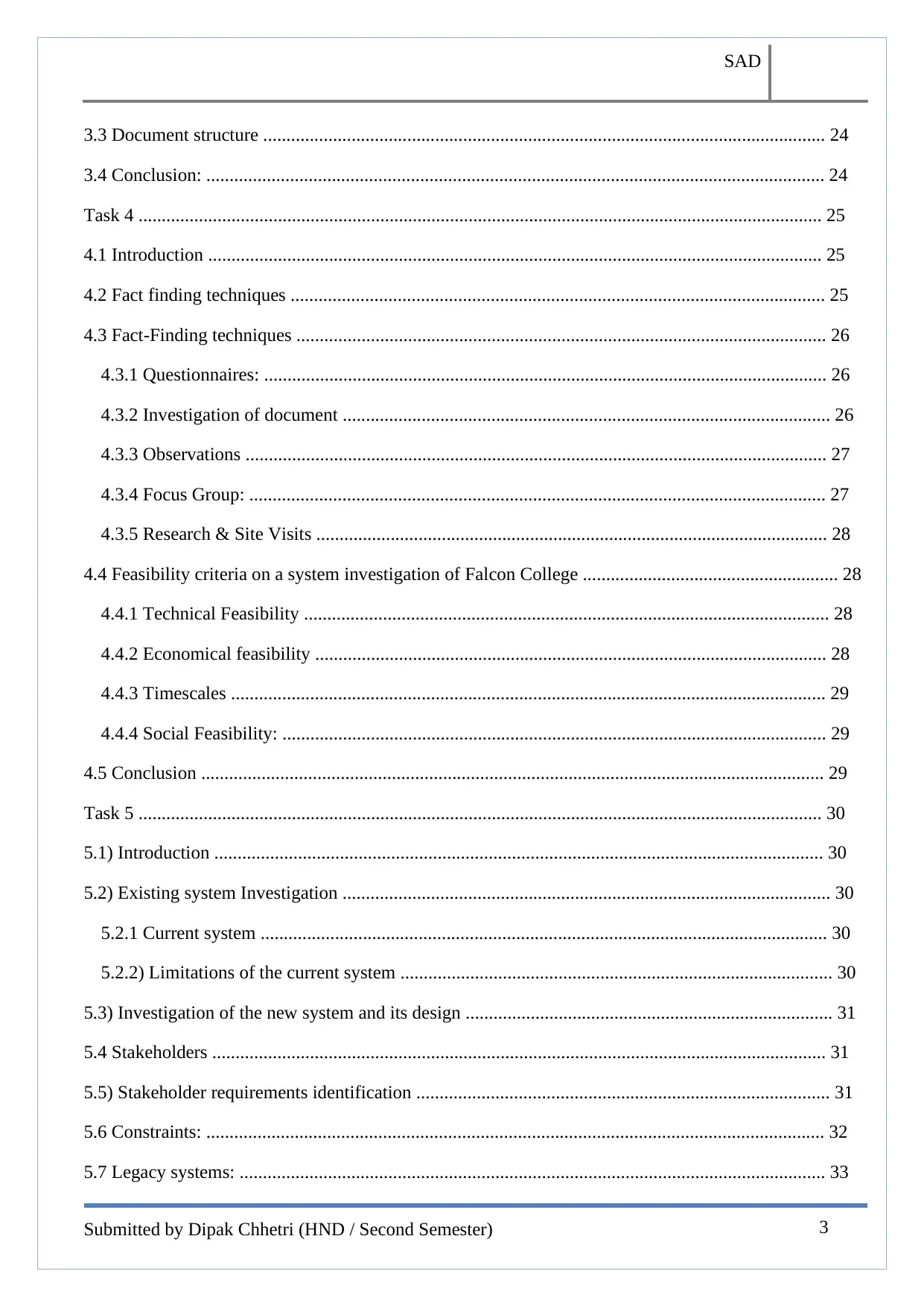
SAD
Submitted by Dipak Chhetri (HND / Second Semester) 3
3.3 Document structure ......................................................................................................................... 24
3.4 Conclusion: ..................................................................................................................................... 24
Task 4 ................................................................................................................................................... 25
4.1 Introduction .................................................................................................................................... 25
4.2 Fact finding techniques ................................................................................................................... 25
4.3 Fact-Finding techniques .................................................................................................................. 26
4.3.1 Questionnaires: ......................................................................................................................... 26
4.3.2 Investigation of document ......................................................................................................... 26
4.3.3 Observations ............................................................................................................................. 27
4.3.4 Focus Group: ............................................................................................................................ 27
4.3.5 Research & Site Visits .............................................................................................................. 28
4.4 Feasibility criteria on a system investigation of Falcon College ....................................................... 28
4.4.1 Technical Feasibility ................................................................................................................. 28
4.4.2 Economical feasibility .............................................................................................................. 28
4.4.3 Timescales ................................................................................................................................ 29
4.4.4 Social Feasibility: ..................................................................................................................... 29
4.5 Conclusion ...................................................................................................................................... 29
Task 5 ................................................................................................................................................... 30
5.1) Introduction ................................................................................................................................... 30
5.2) Existing system Investigation ......................................................................................................... 30
5.2.1 Current system .......................................................................................................................... 30
5.2.2) Limitations of the current system ............................................................................................. 30
5.3) Investigation of the new system and its design ............................................................................... 31
5.4 Stakeholders .................................................................................................................................... 31
5.5) Stakeholder requirements identification ......................................................................................... 31
5.6 Constraints: ..................................................................................................................................... 32
5.7 Legacy systems: .............................................................................................................................. 33
Submitted by Dipak Chhetri (HND / Second Semester) 3
3.3 Document structure ......................................................................................................................... 24
3.4 Conclusion: ..................................................................................................................................... 24
Task 4 ................................................................................................................................................... 25
4.1 Introduction .................................................................................................................................... 25
4.2 Fact finding techniques ................................................................................................................... 25
4.3 Fact-Finding techniques .................................................................................................................. 26
4.3.1 Questionnaires: ......................................................................................................................... 26
4.3.2 Investigation of document ......................................................................................................... 26
4.3.3 Observations ............................................................................................................................. 27
4.3.4 Focus Group: ............................................................................................................................ 27
4.3.5 Research & Site Visits .............................................................................................................. 28
4.4 Feasibility criteria on a system investigation of Falcon College ....................................................... 28
4.4.1 Technical Feasibility ................................................................................................................. 28
4.4.2 Economical feasibility .............................................................................................................. 28
4.4.3 Timescales ................................................................................................................................ 29
4.4.4 Social Feasibility: ..................................................................................................................... 29
4.5 Conclusion ...................................................................................................................................... 29
Task 5 ................................................................................................................................................... 30
5.1) Introduction ................................................................................................................................... 30
5.2) Existing system Investigation ......................................................................................................... 30
5.2.1 Current system .......................................................................................................................... 30
5.2.2) Limitations of the current system ............................................................................................. 30
5.3) Investigation of the new system and its design ............................................................................... 31
5.4 Stakeholders .................................................................................................................................... 31
5.5) Stakeholder requirements identification ......................................................................................... 31
5.6 Constraints: ..................................................................................................................................... 32
5.7 Legacy systems: .............................................................................................................................. 33
Paraphrase This Document
Need a fresh take? Get an instant paraphrase of this document with our AI Paraphraser
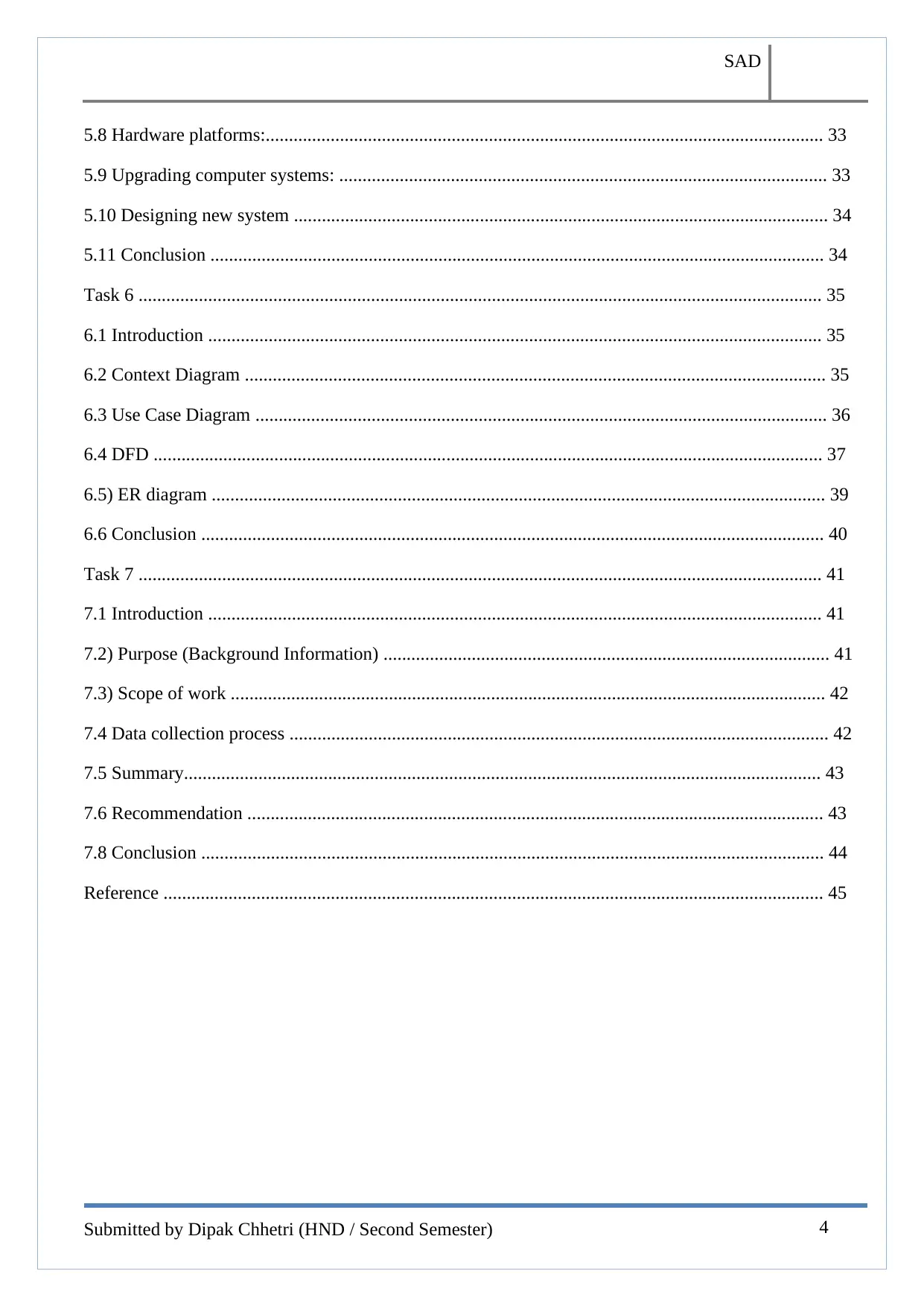
SAD
Submitted by Dipak Chhetri (HND / Second Semester) 4
5.8 Hardware platforms:........................................................................................................................ 33
5.9 Upgrading computer systems: ......................................................................................................... 33
5.10 Designing new system ................................................................................................................... 34
5.11 Conclusion .................................................................................................................................... 34
Task 6 ................................................................................................................................................... 35
6.1 Introduction .................................................................................................................................... 35
6.2 Context Diagram ............................................................................................................................. 35
6.3 Use Case Diagram ........................................................................................................................... 36
6.4 DFD ................................................................................................................................................ 37
6.5) ER diagram .................................................................................................................................... 39
6.6 Conclusion ...................................................................................................................................... 40
Task 7 ................................................................................................................................................... 41
7.1 Introduction .................................................................................................................................... 41
7.2) Purpose (Background Information) ................................................................................................ 41
7.3) Scope of work ................................................................................................................................ 42
7.4 Data collection process .................................................................................................................... 42
7.5 Summary......................................................................................................................................... 43
7.6 Recommendation ............................................................................................................................ 43
7.8 Conclusion ...................................................................................................................................... 44
Reference .............................................................................................................................................. 45
Submitted by Dipak Chhetri (HND / Second Semester) 4
5.8 Hardware platforms:........................................................................................................................ 33
5.9 Upgrading computer systems: ......................................................................................................... 33
5.10 Designing new system ................................................................................................................... 34
5.11 Conclusion .................................................................................................................................... 34
Task 6 ................................................................................................................................................... 35
6.1 Introduction .................................................................................................................................... 35
6.2 Context Diagram ............................................................................................................................. 35
6.3 Use Case Diagram ........................................................................................................................... 36
6.4 DFD ................................................................................................................................................ 37
6.5) ER diagram .................................................................................................................................... 39
6.6 Conclusion ...................................................................................................................................... 40
Task 7 ................................................................................................................................................... 41
7.1 Introduction .................................................................................................................................... 41
7.2) Purpose (Background Information) ................................................................................................ 41
7.3) Scope of work ................................................................................................................................ 42
7.4 Data collection process .................................................................................................................... 42
7.5 Summary......................................................................................................................................... 43
7.6 Recommendation ............................................................................................................................ 43
7.8 Conclusion ...................................................................................................................................... 44
Reference .............................................................................................................................................. 45
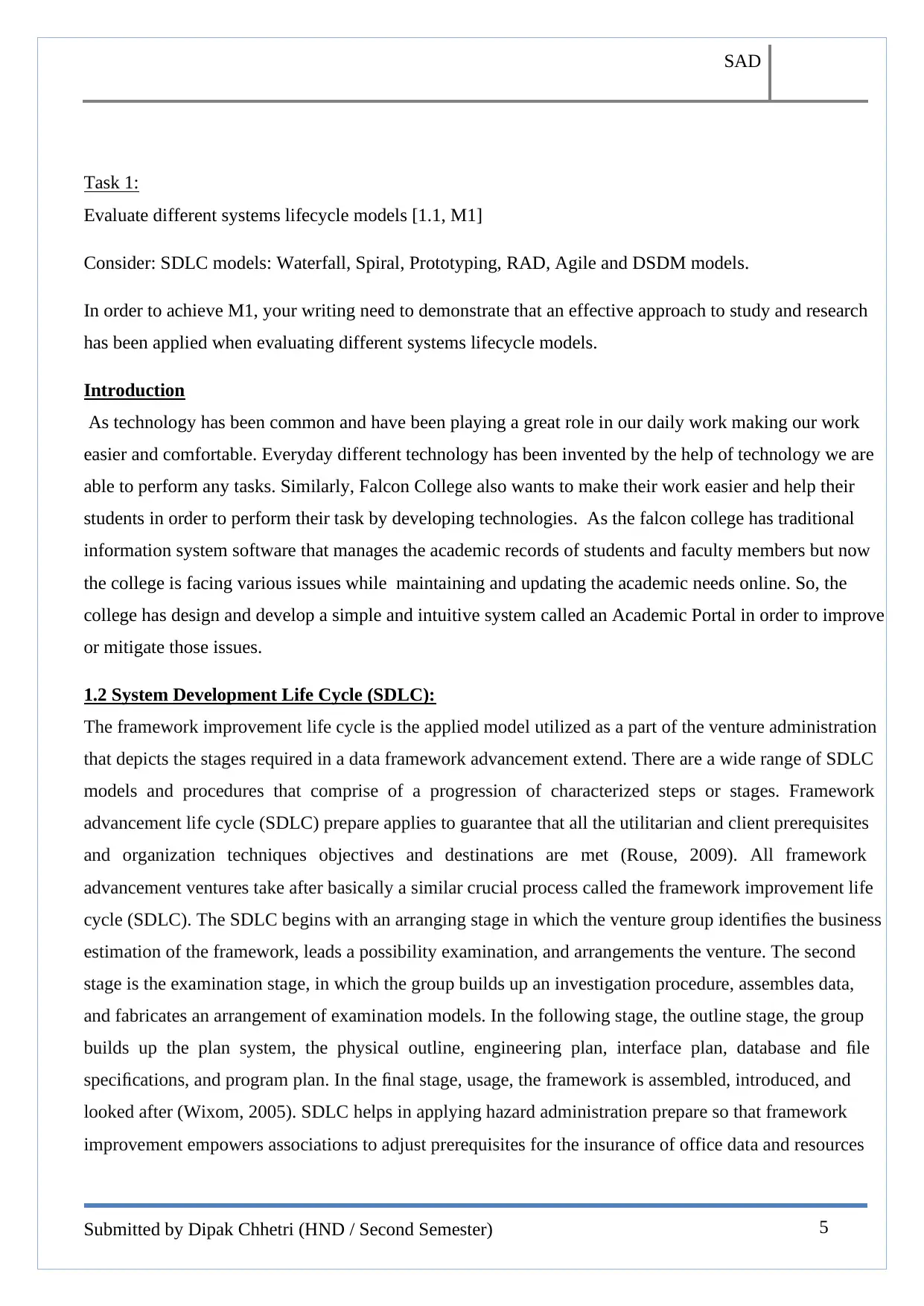
SAD
Submitted by Dipak Chhetri (HND / Second Semester) 5
Task 1:
Evaluate different systems lifecycle models [1.1, M1]
Consider: SDLC models: Waterfall, Spiral, Prototyping, RAD, Agile and DSDM models.
In order to achieve M1, your writing need to demonstrate that an effective approach to study and research
has been applied when evaluating different systems lifecycle models.
Introduction
As technology has been common and have been playing a great role in our daily work making our work
easier and comfortable. Everyday different technology has been invented by the help of technology we are
able to perform any tasks. Similarly, Falcon College also wants to make their work easier and help their
students in order to perform their task by developing technologies. As the falcon college has traditional
information system software that manages the academic records of students and faculty members but now
the college is facing various issues while maintaining and updating the academic needs online. So, the
college has design and develop a simple and intuitive system called an Academic Portal in order to improve
or mitigate those issues.
1.2 System Development Life Cycle (SDLC):
The framework improvement life cycle is the applied model utilized as a part of the venture administration
that depicts the stages required in a data framework advancement extend. There are a wide range of SDLC
models and procedures that comprise of a progression of characterized steps or stages. Framework
advancement life cycle (SDLC) prepare applies to guarantee that all the utilitarian and client prerequisites
and organization techniques objectives and destinations are met (Rouse, 2009). All framework
advancement ventures take after basically a similar crucial process called the framework improvement life
cycle (SDLC). The SDLC begins with an arranging stage in which the venture group identifies the business
estimation of the framework, leads a possibility examination, and arrangements the venture. The second
stage is the examination stage, in which the group builds up an investigation procedure, assembles data,
and fabricates an arrangement of examination models. In the following stage, the outline stage, the group
builds up the plan system, the physical outline, engineering plan, interface plan, database and file
specifications, and program plan. In the final stage, usage, the framework is assembled, introduced, and
looked after (Wixom, 2005). SDLC helps in applying hazard administration prepare so that framework
improvement empowers associations to adjust prerequisites for the insurance of office data and resources
Submitted by Dipak Chhetri (HND / Second Semester) 5
Task 1:
Evaluate different systems lifecycle models [1.1, M1]
Consider: SDLC models: Waterfall, Spiral, Prototyping, RAD, Agile and DSDM models.
In order to achieve M1, your writing need to demonstrate that an effective approach to study and research
has been applied when evaluating different systems lifecycle models.
Introduction
As technology has been common and have been playing a great role in our daily work making our work
easier and comfortable. Everyday different technology has been invented by the help of technology we are
able to perform any tasks. Similarly, Falcon College also wants to make their work easier and help their
students in order to perform their task by developing technologies. As the falcon college has traditional
information system software that manages the academic records of students and faculty members but now
the college is facing various issues while maintaining and updating the academic needs online. So, the
college has design and develop a simple and intuitive system called an Academic Portal in order to improve
or mitigate those issues.
1.2 System Development Life Cycle (SDLC):
The framework improvement life cycle is the applied model utilized as a part of the venture administration
that depicts the stages required in a data framework advancement extend. There are a wide range of SDLC
models and procedures that comprise of a progression of characterized steps or stages. Framework
advancement life cycle (SDLC) prepare applies to guarantee that all the utilitarian and client prerequisites
and organization techniques objectives and destinations are met (Rouse, 2009). All framework
advancement ventures take after basically a similar crucial process called the framework improvement life
cycle (SDLC). The SDLC begins with an arranging stage in which the venture group identifies the business
estimation of the framework, leads a possibility examination, and arrangements the venture. The second
stage is the examination stage, in which the group builds up an investigation procedure, assembles data,
and fabricates an arrangement of examination models. In the following stage, the outline stage, the group
builds up the plan system, the physical outline, engineering plan, interface plan, database and file
specifications, and program plan. In the final stage, usage, the framework is assembled, introduced, and
looked after (Wixom, 2005). SDLC helps in applying hazard administration prepare so that framework
improvement empowers associations to adjust prerequisites for the insurance of office data and resources
⊘ This is a preview!⊘
Do you want full access?
Subscribe today to unlock all pages.

Trusted by 1+ million students worldwide
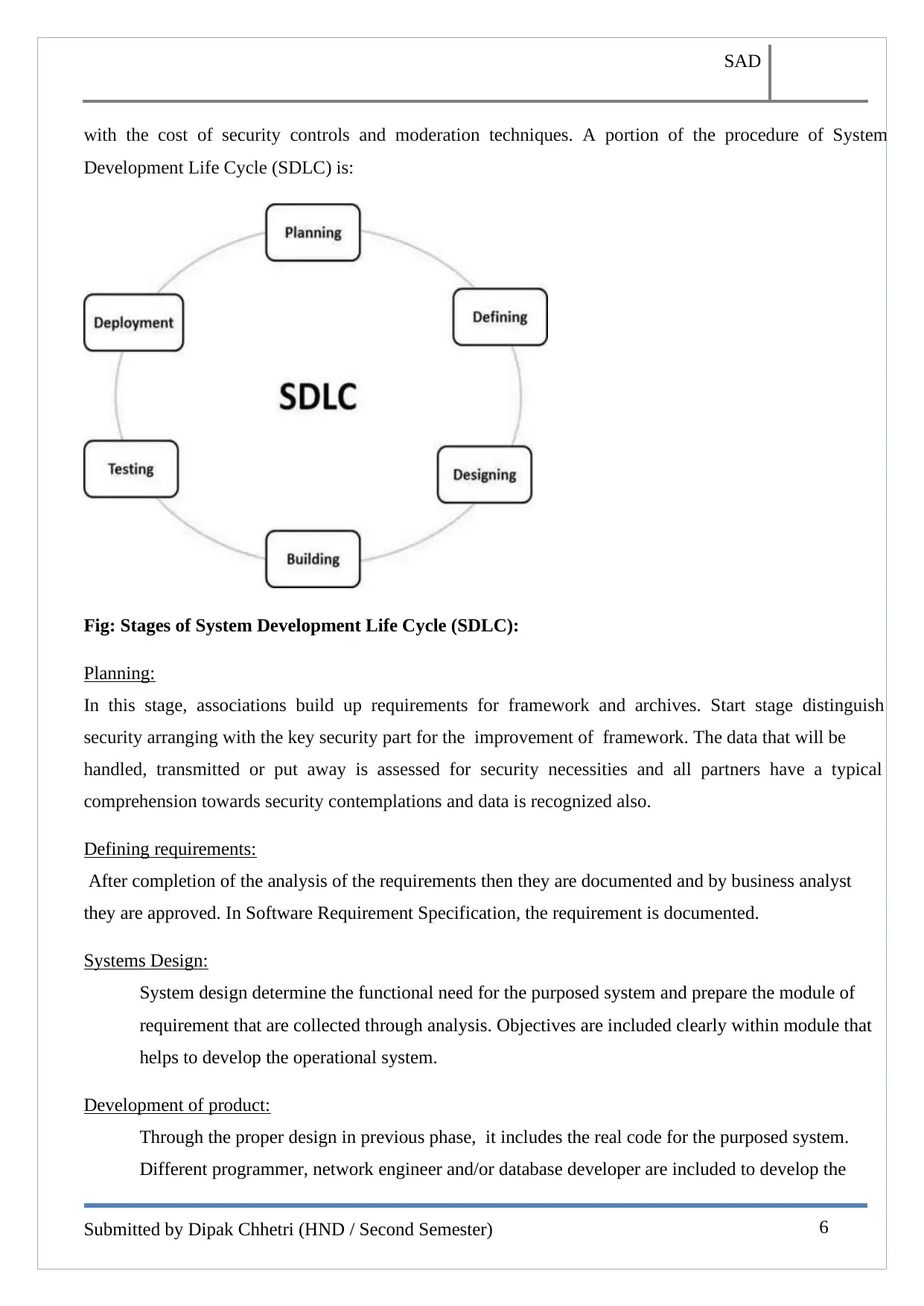
SAD
Submitted by Dipak Chhetri (HND / Second Semester) 6
with the cost of security controls and moderation techniques. A portion of the procedure of System
Development Life Cycle (SDLC) is:
Fig: Stages of System Development Life Cycle (SDLC):
Planning:
In this stage, associations build up requirements for framework and archives. Start stage distinguish
security arranging with the key security part for the improvement of framework. The data that will be
handled, transmitted or put away is assessed for security necessities and all partners have a typical
comprehension towards security contemplations and data is recognized also.
Defining requirements:
After completion of the analysis of the requirements then they are documented and by business analyst
they are approved. In Software Requirement Specification, the requirement is documented.
Systems Design:
System design determine the functional need for the purposed system and prepare the module of
requirement that are collected through analysis. Objectives are included clearly within module that
helps to develop the operational system.
Development of product:
Through the proper design in previous phase, it includes the real code for the purposed system.
Different programmer, network engineer and/or database developer are included to develop the
Submitted by Dipak Chhetri (HND / Second Semester) 6
with the cost of security controls and moderation techniques. A portion of the procedure of System
Development Life Cycle (SDLC) is:
Fig: Stages of System Development Life Cycle (SDLC):
Planning:
In this stage, associations build up requirements for framework and archives. Start stage distinguish
security arranging with the key security part for the improvement of framework. The data that will be
handled, transmitted or put away is assessed for security necessities and all partners have a typical
comprehension towards security contemplations and data is recognized also.
Defining requirements:
After completion of the analysis of the requirements then they are documented and by business analyst
they are approved. In Software Requirement Specification, the requirement is documented.
Systems Design:
System design determine the functional need for the purposed system and prepare the module of
requirement that are collected through analysis. Objectives are included clearly within module that
helps to develop the operational system.
Development of product:
Through the proper design in previous phase, it includes the real code for the purposed system.
Different programmer, network engineer and/or database developer are included to develop the
Paraphrase This Document
Need a fresh take? Get an instant paraphrase of this document with our AI Paraphraser
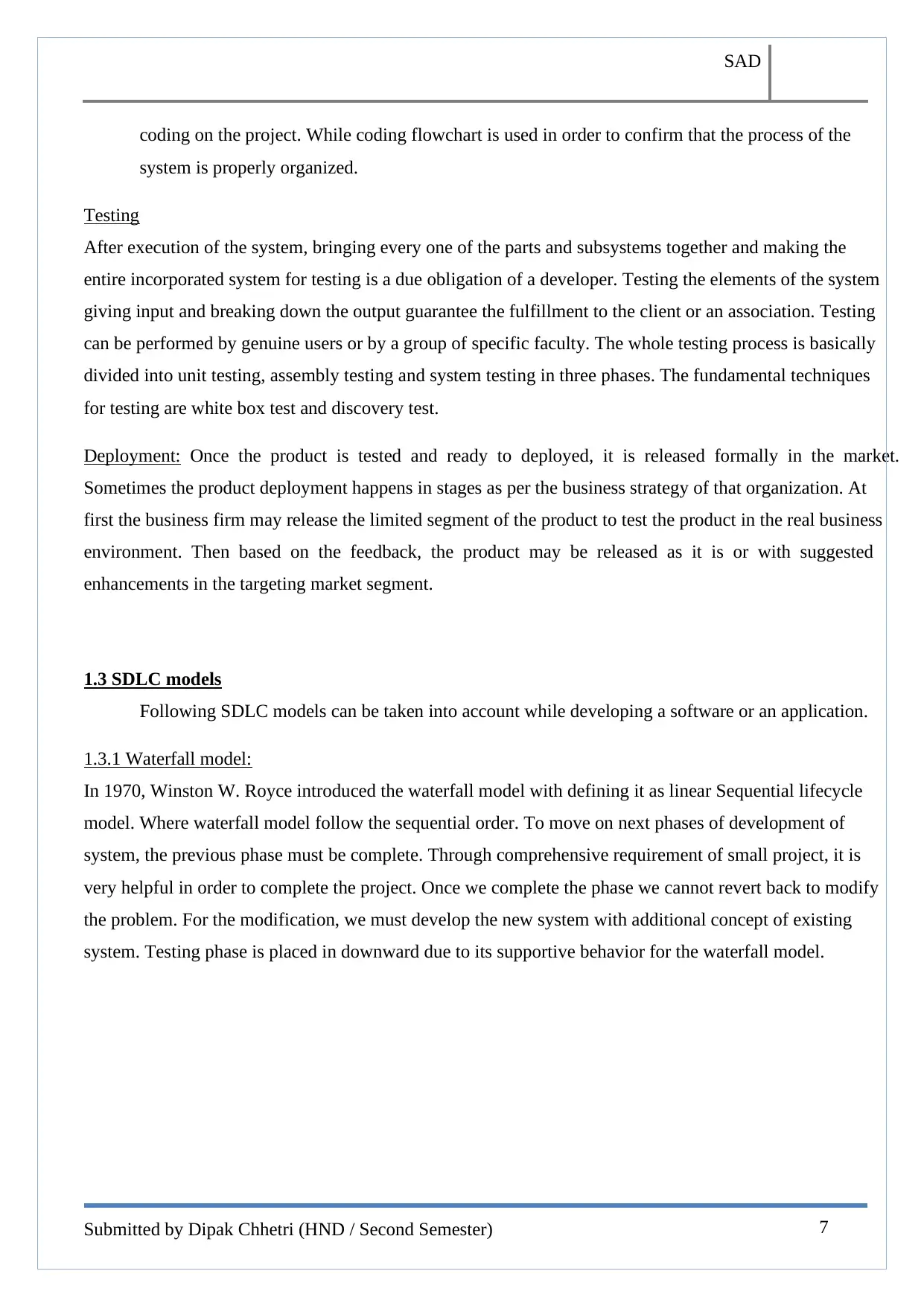
SAD
Submitted by Dipak Chhetri (HND / Second Semester) 7
coding on the project. While coding flowchart is used in order to confirm that the process of the
system is properly organized.
Testing
After execution of the system, bringing every one of the parts and subsystems together and making the
entire incorporated system for testing is a due obligation of a developer. Testing the elements of the system
giving input and breaking down the output guarantee the fulfillment to the client or an association. Testing
can be performed by genuine users or by a group of specific faculty. The whole testing process is basically
divided into unit testing, assembly testing and system testing in three phases. The fundamental techniques
for testing are white box test and discovery test.
Deployment: Once the product is tested and ready to deployed, it is released formally in the market.
Sometimes the product deployment happens in stages as per the business strategy of that organization. At
first the business firm may release the limited segment of the product to test the product in the real business
environment. Then based on the feedback, the product may be released as it is or with suggested
enhancements in the targeting market segment.
1.3 SDLC models
Following SDLC models can be taken into account while developing a software or an application.
1.3.1 Waterfall model:
In 1970, Winston W. Royce introduced the waterfall model with defining it as linear Sequential lifecycle
model. Where waterfall model follow the sequential order. To move on next phases of development of
system, the previous phase must be complete. Through comprehensive requirement of small project, it is
very helpful in order to complete the project. Once we complete the phase we cannot revert back to modify
the problem. For the modification, we must develop the new system with additional concept of existing
system. Testing phase is placed in downward due to its supportive behavior for the waterfall model.
Submitted by Dipak Chhetri (HND / Second Semester) 7
coding on the project. While coding flowchart is used in order to confirm that the process of the
system is properly organized.
Testing
After execution of the system, bringing every one of the parts and subsystems together and making the
entire incorporated system for testing is a due obligation of a developer. Testing the elements of the system
giving input and breaking down the output guarantee the fulfillment to the client or an association. Testing
can be performed by genuine users or by a group of specific faculty. The whole testing process is basically
divided into unit testing, assembly testing and system testing in three phases. The fundamental techniques
for testing are white box test and discovery test.
Deployment: Once the product is tested and ready to deployed, it is released formally in the market.
Sometimes the product deployment happens in stages as per the business strategy of that organization. At
first the business firm may release the limited segment of the product to test the product in the real business
environment. Then based on the feedback, the product may be released as it is or with suggested
enhancements in the targeting market segment.
1.3 SDLC models
Following SDLC models can be taken into account while developing a software or an application.
1.3.1 Waterfall model:
In 1970, Winston W. Royce introduced the waterfall model with defining it as linear Sequential lifecycle
model. Where waterfall model follow the sequential order. To move on next phases of development of
system, the previous phase must be complete. Through comprehensive requirement of small project, it is
very helpful in order to complete the project. Once we complete the phase we cannot revert back to modify
the problem. For the modification, we must develop the new system with additional concept of existing
system. Testing phase is placed in downward due to its supportive behavior for the waterfall model.
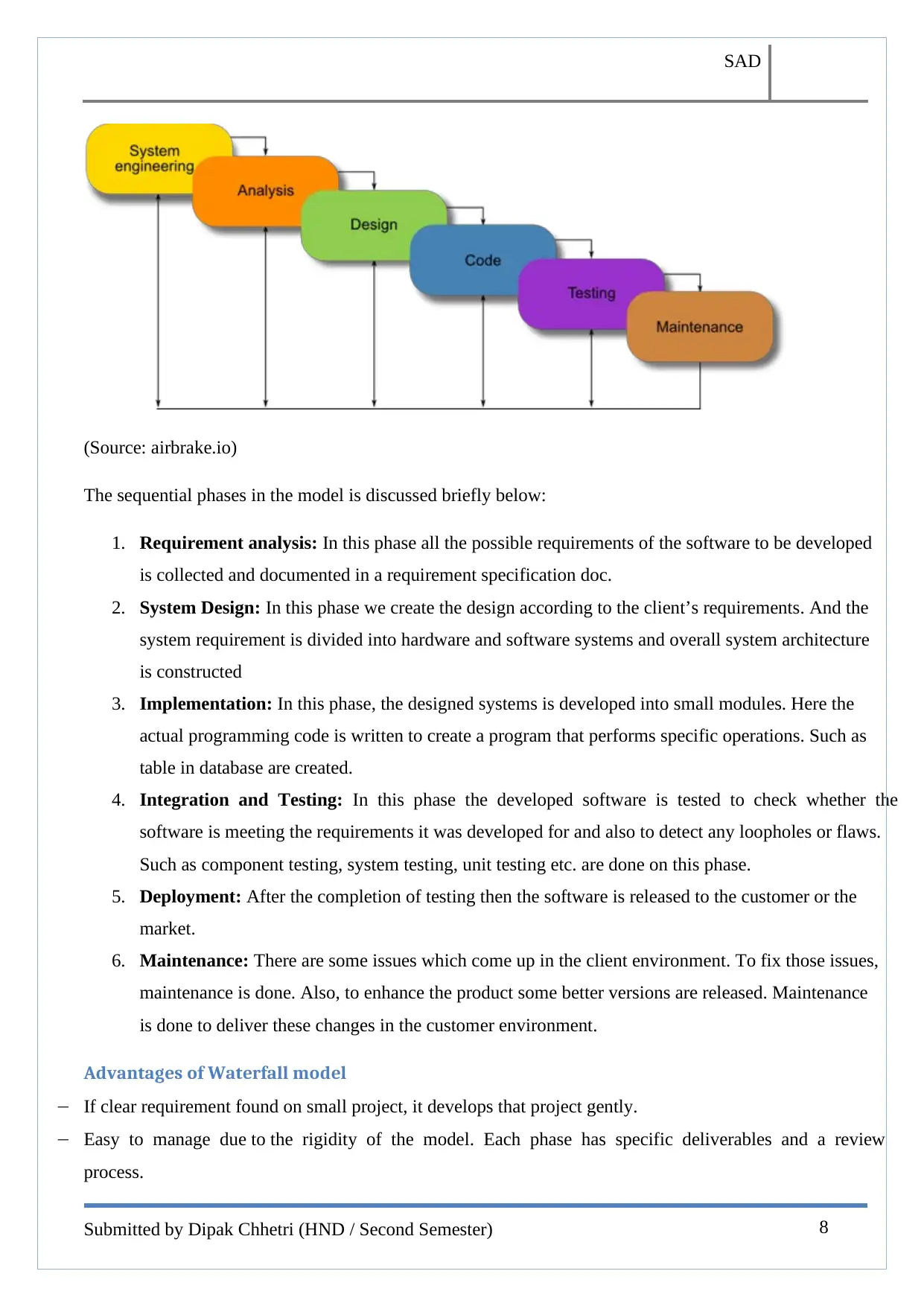
SAD
Submitted by Dipak Chhetri (HND / Second Semester) 8
(Source: airbrake.io)
The sequential phases in the model is discussed briefly below:
1. Requirement analysis: In this phase all the possible requirements of the software to be developed
is collected and documented in a requirement specification doc.
2. System Design: In this phase we create the design according to the client’s requirements. And the
system requirement is divided into hardware and software systems and overall system architecture
is constructed
3. Implementation: In this phase, the designed systems is developed into small modules. Here the
actual programming code is written to create a program that performs specific operations. Such as
table in database are created.
4. Integration and Testing: In this phase the developed software is tested to check whether the
software is meeting the requirements it was developed for and also to detect any loopholes or flaws.
Such as component testing, system testing, unit testing etc. are done on this phase.
5. Deployment: After the completion of testing then the software is released to the customer or the
market.
6. Maintenance: There are some issues which come up in the client environment. To fix those issues,
maintenance is done. Also, to enhance the product some better versions are released. Maintenance
is done to deliver these changes in the customer environment.
Advantages of Waterfall model
− If clear requirement found on small project, it develops that project gently.
− Easy to manage due to the rigidity of the model. Each phase has specific deliverables and a review
process.
Submitted by Dipak Chhetri (HND / Second Semester) 8
(Source: airbrake.io)
The sequential phases in the model is discussed briefly below:
1. Requirement analysis: In this phase all the possible requirements of the software to be developed
is collected and documented in a requirement specification doc.
2. System Design: In this phase we create the design according to the client’s requirements. And the
system requirement is divided into hardware and software systems and overall system architecture
is constructed
3. Implementation: In this phase, the designed systems is developed into small modules. Here the
actual programming code is written to create a program that performs specific operations. Such as
table in database are created.
4. Integration and Testing: In this phase the developed software is tested to check whether the
software is meeting the requirements it was developed for and also to detect any loopholes or flaws.
Such as component testing, system testing, unit testing etc. are done on this phase.
5. Deployment: After the completion of testing then the software is released to the customer or the
market.
6. Maintenance: There are some issues which come up in the client environment. To fix those issues,
maintenance is done. Also, to enhance the product some better versions are released. Maintenance
is done to deliver these changes in the customer environment.
Advantages of Waterfall model
− If clear requirement found on small project, it develops that project gently.
− Easy to manage due to the rigidity of the model. Each phase has specific deliverables and a review
process.
⊘ This is a preview!⊘
Do you want full access?
Subscribe today to unlock all pages.

Trusted by 1+ million students worldwide
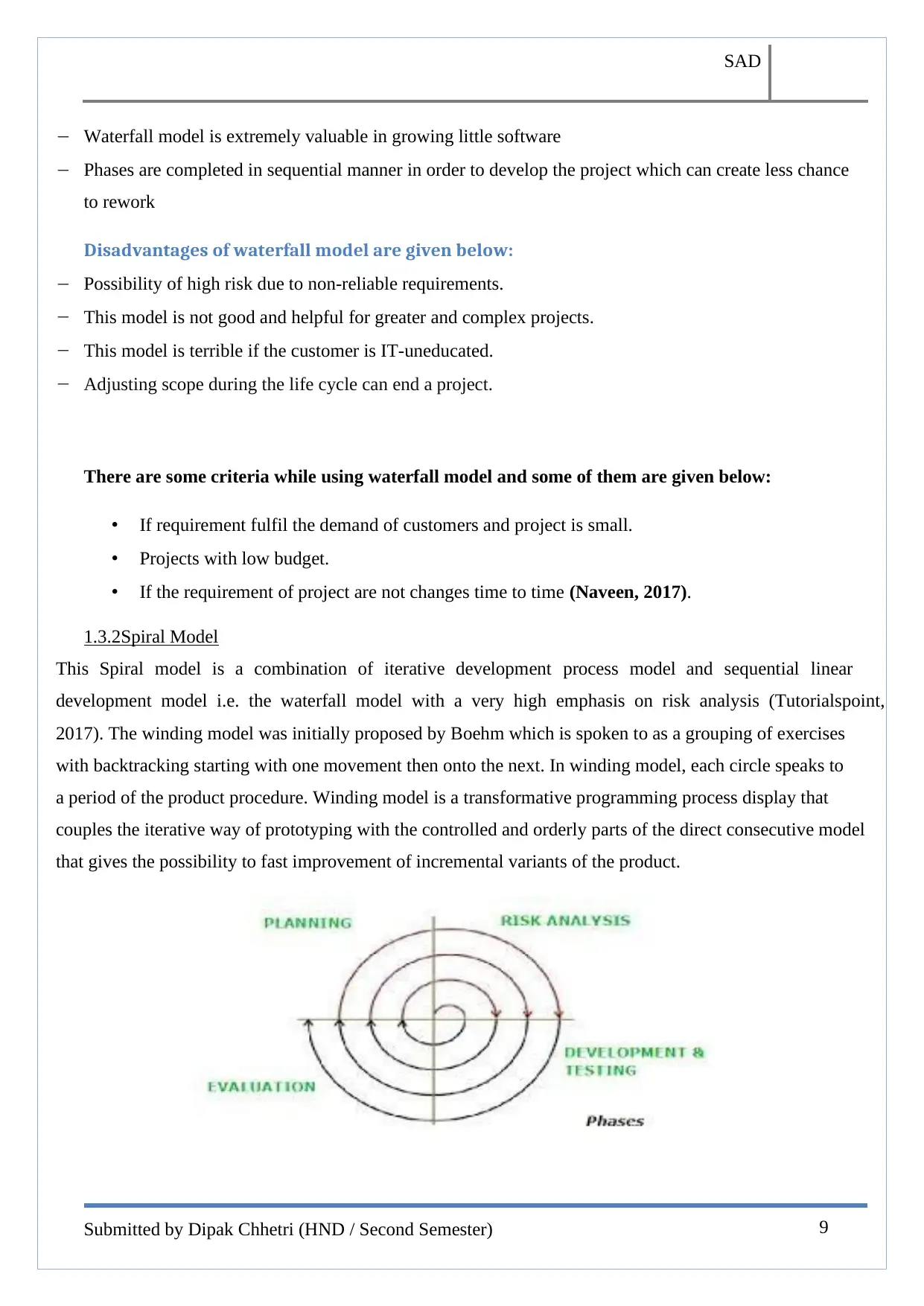
SAD
Submitted by Dipak Chhetri (HND / Second Semester) 9
− Waterfall model is extremely valuable in growing little software
− Phases are completed in sequential manner in order to develop the project which can create less chance
to rework
Disadvantages of waterfall model are given below:
− Possibility of high risk due to non-reliable requirements.
− This model is not good and helpful for greater and complex projects.
− This model is terrible if the customer is IT-uneducated.
− Adjusting scope during the life cycle can end a project.
There are some criteria while using waterfall model and some of them are given below:
• If requirement fulfil the demand of customers and project is small.
• Projects with low budget.
• If the requirement of project are not changes time to time (Naveen, 2017).
1.3.2Spiral Model
This Spiral model is a combination of iterative development process model and sequential linear
development model i.e. the waterfall model with a very high emphasis on risk analysis (Tutorialspoint,
2017). The winding model was initially proposed by Boehm which is spoken to as a grouping of exercises
with backtracking starting with one movement then onto the next. In winding model, each circle speaks to
a period of the product procedure. Winding model is a transformative programming process display that
couples the iterative way of prototyping with the controlled and orderly parts of the direct consecutive model
that gives the possibility to fast improvement of incremental variants of the product.
Submitted by Dipak Chhetri (HND / Second Semester) 9
− Waterfall model is extremely valuable in growing little software
− Phases are completed in sequential manner in order to develop the project which can create less chance
to rework
Disadvantages of waterfall model are given below:
− Possibility of high risk due to non-reliable requirements.
− This model is not good and helpful for greater and complex projects.
− This model is terrible if the customer is IT-uneducated.
− Adjusting scope during the life cycle can end a project.
There are some criteria while using waterfall model and some of them are given below:
• If requirement fulfil the demand of customers and project is small.
• Projects with low budget.
• If the requirement of project are not changes time to time (Naveen, 2017).
1.3.2Spiral Model
This Spiral model is a combination of iterative development process model and sequential linear
development model i.e. the waterfall model with a very high emphasis on risk analysis (Tutorialspoint,
2017). The winding model was initially proposed by Boehm which is spoken to as a grouping of exercises
with backtracking starting with one movement then onto the next. In winding model, each circle speaks to
a period of the product procedure. Winding model is a transformative programming process display that
couples the iterative way of prototyping with the controlled and orderly parts of the direct consecutive model
that gives the possibility to fast improvement of incremental variants of the product.
Paraphrase This Document
Need a fresh take? Get an instant paraphrase of this document with our AI Paraphraser
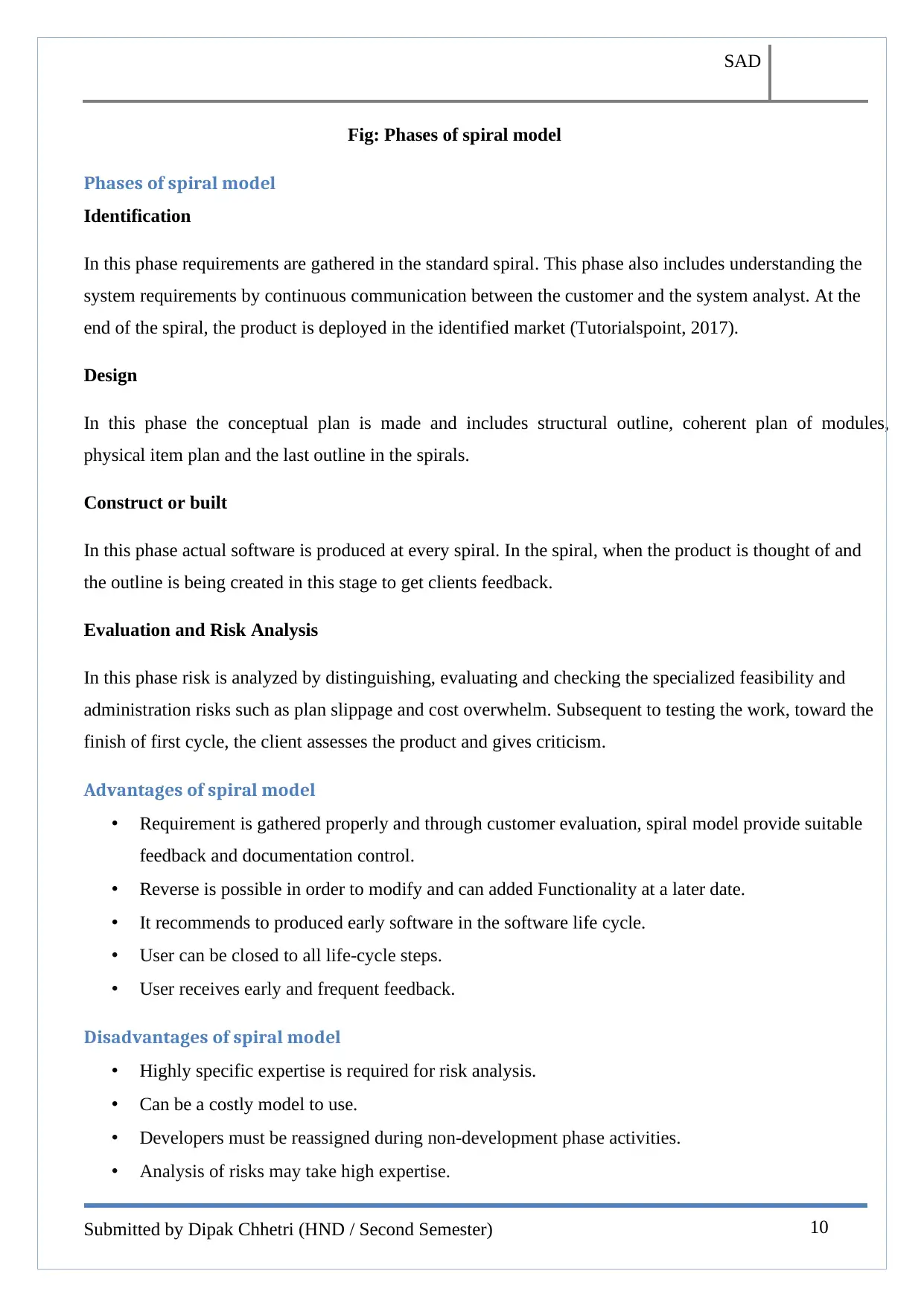
SAD
Submitted by Dipak Chhetri (HND / Second Semester) 10
Fig: Phases of spiral model
Phases of spiral model
Identification
In this phase requirements are gathered in the standard spiral. This phase also includes understanding the
system requirements by continuous communication between the customer and the system analyst. At the
end of the spiral, the product is deployed in the identified market (Tutorialspoint, 2017).
Design
In this phase the conceptual plan is made and includes structural outline, coherent plan of modules,
physical item plan and the last outline in the spirals.
Construct or built
In this phase actual software is produced at every spiral. In the spiral, when the product is thought of and
the outline is being created in this stage to get clients feedback.
Evaluation and Risk Analysis
In this phase risk is analyzed by distinguishing, evaluating and checking the specialized feasibility and
administration risks such as plan slippage and cost overwhelm. Subsequent to testing the work, toward the
finish of first cycle, the client assesses the product and gives criticism.
Advantages of spiral model
• Requirement is gathered properly and through customer evaluation, spiral model provide suitable
feedback and documentation control.
• Reverse is possible in order to modify and can added Functionality at a later date.
• It recommends to produced early software in the software life cycle.
• User can be closed to all life-cycle steps.
• User receives early and frequent feedback.
Disadvantages of spiral model
• Highly specific expertise is required for risk analysis.
• Can be a costly model to use.
• Developers must be reassigned during non-development phase activities.
• Analysis of risks may take high expertise.
Submitted by Dipak Chhetri (HND / Second Semester) 10
Fig: Phases of spiral model
Phases of spiral model
Identification
In this phase requirements are gathered in the standard spiral. This phase also includes understanding the
system requirements by continuous communication between the customer and the system analyst. At the
end of the spiral, the product is deployed in the identified market (Tutorialspoint, 2017).
Design
In this phase the conceptual plan is made and includes structural outline, coherent plan of modules,
physical item plan and the last outline in the spirals.
Construct or built
In this phase actual software is produced at every spiral. In the spiral, when the product is thought of and
the outline is being created in this stage to get clients feedback.
Evaluation and Risk Analysis
In this phase risk is analyzed by distinguishing, evaluating and checking the specialized feasibility and
administration risks such as plan slippage and cost overwhelm. Subsequent to testing the work, toward the
finish of first cycle, the client assesses the product and gives criticism.
Advantages of spiral model
• Requirement is gathered properly and through customer evaluation, spiral model provide suitable
feedback and documentation control.
• Reverse is possible in order to modify and can added Functionality at a later date.
• It recommends to produced early software in the software life cycle.
• User can be closed to all life-cycle steps.
• User receives early and frequent feedback.
Disadvantages of spiral model
• Highly specific expertise is required for risk analysis.
• Can be a costly model to use.
• Developers must be reassigned during non-development phase activities.
• Analysis of risks may take high expertise.
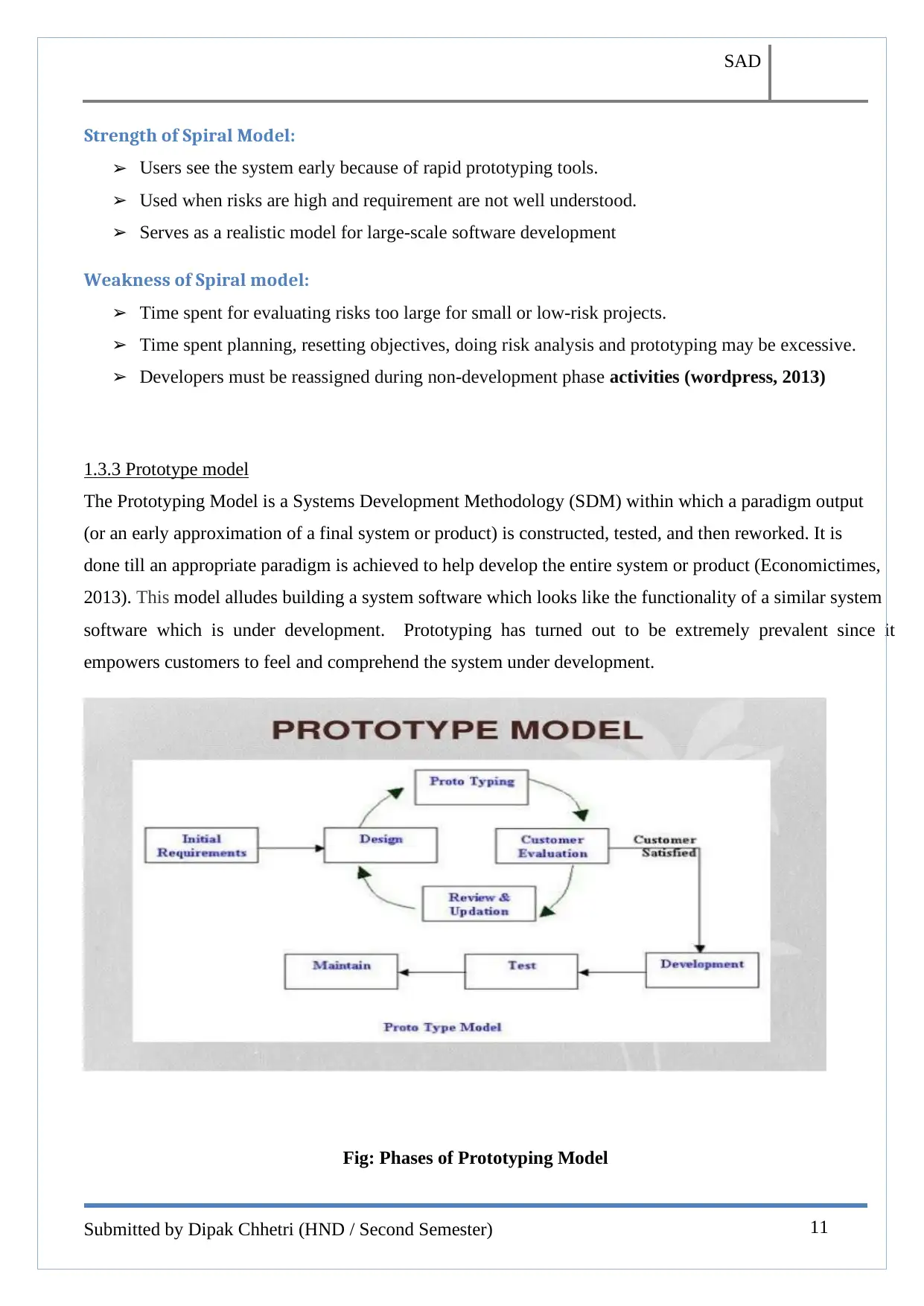
SAD
Submitted by Dipak Chhetri (HND / Second Semester) 11
Strength of Spiral Model:
➢ Users see the system early because of rapid prototyping tools.
➢ Used when risks are high and requirement are not well understood.
➢ Serves as a realistic model for large-scale software development
Weakness of Spiral model:
➢ Time spent for evaluating risks too large for small or low-risk projects.
➢ Time spent planning, resetting objectives, doing risk analysis and prototyping may be excessive.
➢ Developers must be reassigned during non-development phase activities (wordpress, 2013)
1.3.3 Prototype model
The Prototyping Model is a Systems Development Methodology (SDM) within which a paradigm output
(or an early approximation of a final system or product) is constructed, tested, and then reworked. It is
done till an appropriate paradigm is achieved to help develop the entire system or product (Economictimes,
2013). This model alludes building a system software which looks like the functionality of a similar system
software which is under development. Prototyping has turned out to be extremely prevalent since it
empowers customers to feel and comprehend the system under development.
Fig: Phases of Prototyping Model
Submitted by Dipak Chhetri (HND / Second Semester) 11
Strength of Spiral Model:
➢ Users see the system early because of rapid prototyping tools.
➢ Used when risks are high and requirement are not well understood.
➢ Serves as a realistic model for large-scale software development
Weakness of Spiral model:
➢ Time spent for evaluating risks too large for small or low-risk projects.
➢ Time spent planning, resetting objectives, doing risk analysis and prototyping may be excessive.
➢ Developers must be reassigned during non-development phase activities (wordpress, 2013)
1.3.3 Prototype model
The Prototyping Model is a Systems Development Methodology (SDM) within which a paradigm output
(or an early approximation of a final system or product) is constructed, tested, and then reworked. It is
done till an appropriate paradigm is achieved to help develop the entire system or product (Economictimes,
2013). This model alludes building a system software which looks like the functionality of a similar system
software which is under development. Prototyping has turned out to be extremely prevalent since it
empowers customers to feel and comprehend the system under development.
Fig: Phases of Prototyping Model
⊘ This is a preview!⊘
Do you want full access?
Subscribe today to unlock all pages.

Trusted by 1+ million students worldwide
1 out of 47
Related Documents
Your All-in-One AI-Powered Toolkit for Academic Success.
+13062052269
info@desklib.com
Available 24*7 on WhatsApp / Email
![[object Object]](/_next/static/media/star-bottom.7253800d.svg)
Unlock your academic potential
Copyright © 2020–2025 A2Z Services. All Rights Reserved. Developed and managed by ZUCOL.





